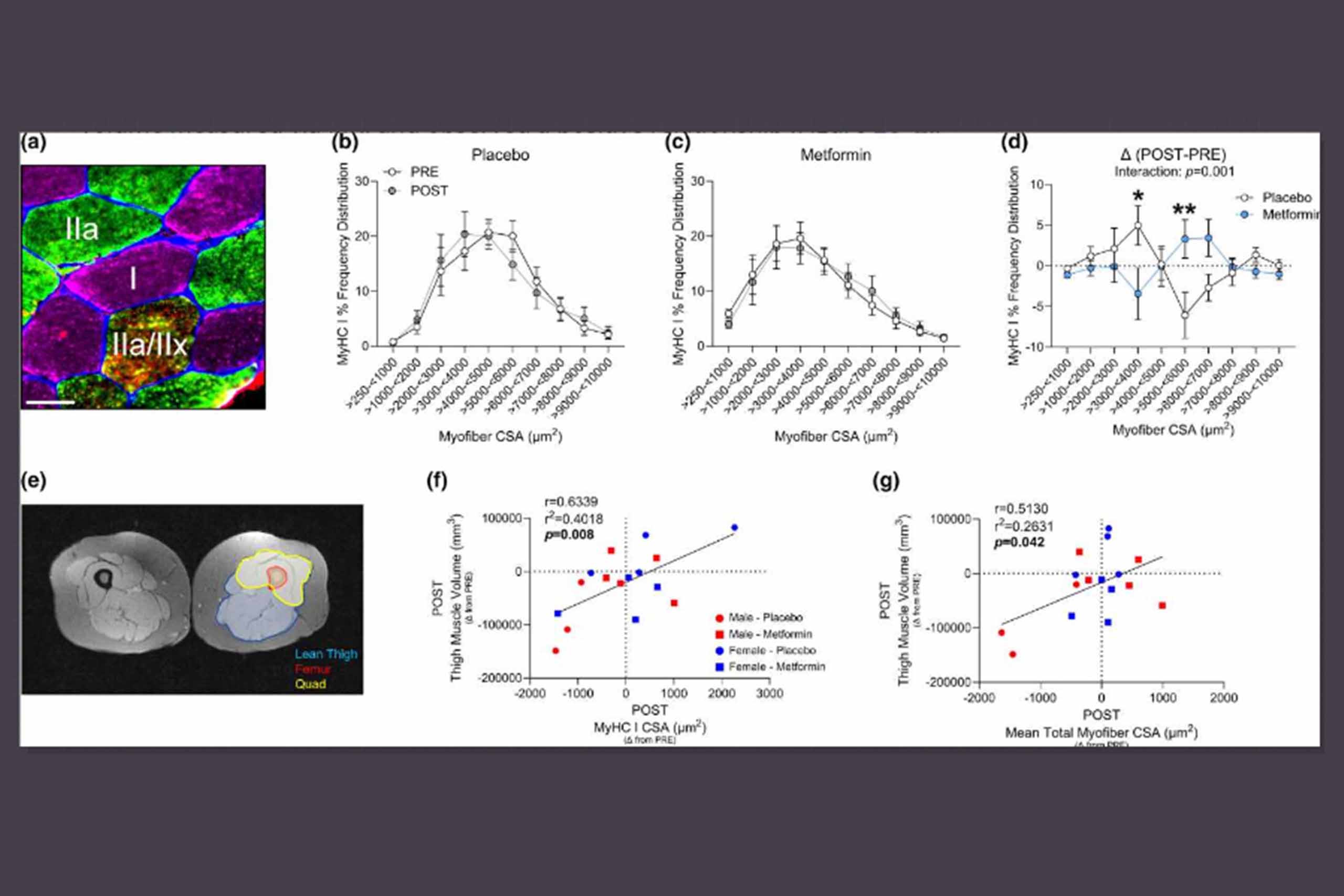Fighting Muscle Loss With Metformin: What Science Reveals
As we age, maintaining muscle health becomes increasingly crucial. However, extended bed rest, often necessary for older adults with injuries or medical conditions, can lead to significant muscle loss.
In this context, a promising ally emerges in the quest to counter this condition: metformin.
Widely known for its role in diabetes management, metformin’s potential to restore muscle mass has caught the attention of researchers.
Read on to learn more about metformin and muscle loss treatment.
Beyond Diabetes: Potential of Metformin in Mitigating Muscle Atrophy
What Happens to Your Muscles if You Don’t Use Them?
Muscle atrophy, a consequence of prolonged muscle disuse, commonly occurs during hospital bed rest, affecting injured individuals and older patients. It involves thinning muscle mass due to decreased protein synthesis and increased protein breakdown.
Affected muscles become visibly smaller, causing one limb to appear smaller than the other. Individuals may also experience numbness, weakness, and tingling in the affected limbs.
So, what causes muscle atrophy, exactly? The culprit behind this debilitating health problem revolves around the principle of “use it or lose it.”
Chronic disuse reduces mechanical loading on muscles, triggering a cascade of molecular events, such as the diminishing activation of key signaling pathways, such as the Akt/mTOR pathway, responsible for promoting muscle protein synthesis.
Concurrently, an upregulation of pathways like the ubiquitin-proteasome system enhances protein breakdown, accelerating muscle degradation.
This combination of reduced protein synthesis and increased breakdown results in the gradual deterioration of muscle fibers, culminating in the observed muscle atrophy.

Can Muscle Atrophy Be Reversed in Older Adults?
Reversing muscle atrophy is feasible in older adults, though it becomes progressively challenging, particularly in those immobilized due to injuries or extended bed rest.
While exercise and a balanced diet rich in whole foods and high-quality proteins are integral to recovery, older debilitated individuals may struggle to access these interventions. This reality underscores the pressing demand for interventional therapies for muscle atrophy treatment that restore muscle mass when conventional methods are unavailable.
In this context, one promising avenue under exploration is metformin.
This oral medication, primarily known for its antidiabetic properties, has shown potential in enhancing muscle function and countering age-related muscle loss.
While research is ongoing, its ability to target cellular pathways associated with muscles offers hope for a novel therapeutic strategy.
What is Metformin? And What is Metformin Used for?
Metformin belongs to the class of biguanides and is utilized primarily to control blood glucose levels in individuals with type 2 diabetes.
Metformin’s antidiabetic properties stem from a multifaceted mechanism of action. It reduces glucose absorption from food and curbs the liver’s glucose production. This double-edged approach helps maintain more stable blood sugar levels. Also, metformin heightens the body’s sensitivity to insulin – a hormone responsible for regulating blood sugar.
This dual action not only aids in decreasing elevated blood glucose but also enhances the ability of cells to utilize insulin.
The benefits of metformin are profound. In diabetes treatment, metformin occupies a central role due to its robust efficacy, favorable safety profile, and capacity to address multiple aspects of the disease, underscoring its importance in diabetes management.
.

What is Metformin Used for Other Than Diabetes?
Beyond its primary role in diabetes, metformin offers potential benefits in mitigating the development of life-threatening complications associated with diabetes.
People with diabetes may face the risk of various complications, including:
- Heart disease
- Stroke
- Kidney dysfunction
- Nerve damage
- Eye issues
Metformin, lifestyle changes, and exercise can synergistically regulate blood sugar and reduce the likelihood of diabetes-related complications. This therapeutic approach may diminish the risks of heart attacks, strokes, and kidney failure.
It also addresses nerve damage characterized by numbness and cold extremities while preserving sexual function. Furthermore, metformin’s usage might contribute to safeguarding eye health by preventing changes or loss of vision.
This broader impact of metformin makes it a crucial tool to enhance health and prevent the debilitating consequences of prolonged high blood sugar levels.
Metformin and Muscle Loss: What Science Reveals
A recent study by Petrocelli et al., published in the Aging Cell journal, investigated the connection between metformin and muscle loss induced by disuse in older adults.
The study employed a two-week run-in period of metformin treatment, followed by 5 days of bed rest and a metformin withdrawal phase during 7 days of recovery.
Metformin Prevents Disuse-induced Muscle Atrophy
The group taking metformin had larger muscle size compared to the group not taking it. Metformin also protects against muscle loss during 5 days of bed rest.
The study also found that the changes in muscle size were related to the enlargement in the whole leg size measured by magnetic resonance imaging (MRI), suggesting metformin might help increase muscle mass even during inactivity.

Metformin prevented muscle atrophy after long periods of bed rest.
Metformin Improves Collagen for Muscle Regrowth
The researchers then studied how metformin affects the “glue” in muscles, called collagen. After recovery, those on metformin had less collagen buildup, a good sign for muscle healing. Metformin also normalized collagen organization, helping muscles regenerate.
Collagen renewal was higher after metformin, showing that this treatment helps muscles rebuild. Also, how collagen was arranged changed, which could mean better muscle health; this finding shows metformin might help muscle recovery after long bed rest.

Metformin reduced collagen deposition and improved collagen remodeling.
Metformin Reduces Cellular Senescence in Muscles
Metformin also seemed to slow down aging in muscle cells. In the study, specific genes (CDK1NA and TP53) linked to aging (cellular senescence) were more active in the group that didn’t take metformin. Meanwhile, metformin had a more substantial effect on muscles after rest, making them look less “old.”
Metformin also impacts specific cells that affect muscle health by maintaining youthful muscle characteristics and preventing age-related changes. This finding suggests that metformin could be helpful for muscles to recover and stay healthier as we age.

Metformin decreased cellular senescence in muscle and fibro-adipogenic progenitors (FAPs).
Bottom Line
Metformin emerges as a promising remedy against muscle atrophy induced by disuse in older adults. The study above reveals that metformin prevents muscle loss during inactivity and promotes muscle regrowth. Moreover, it reduces collagen buildup and cellular senescence, potentially enhancing muscle health and recovery in aging individuals.
These findings suggest metformin’s multifaceted benefits beyond diabetes management in mitigating muscle-related challenges associated with aging and disuse.
References
Bodine S et al. (2001). Akt/mTOR Pathway is a Crucial Regulator of Skeletal Muscle Hypertrophy and Can Prevent Muscle Atrophy in Vivo.
Marshall R et al. (2020). Nutritional Strategies to Offset Disuse-Induced Skeletal Muscle Atrophy and Anabolic Resistance in Older Adults: From Whole-Foods to Isolated Ingredients.
Petrocelli J et al. (2023). Disuse-induced Muscle Fibrosis, Cellular Senescence, and Senescence-associated Secretory Phenotype in Older Adults Are Alleviated During Re-ambulation With Metformin Pre-treatment.
Why Choose Yunique Medical?
Yunique Medical provides FUNCTIONAL MEDICINE for optimized health and performance. We offer customized, scientifically advanced treatments to create a new state of human thriving. Why be ordinary when you can be optimal?
HUMAN 2.0 begins here!
Contact us to schedule your FREE consultation at one of our three locations in Florida – Ocala, Fruitland Park (The Villages), and Daytona.

